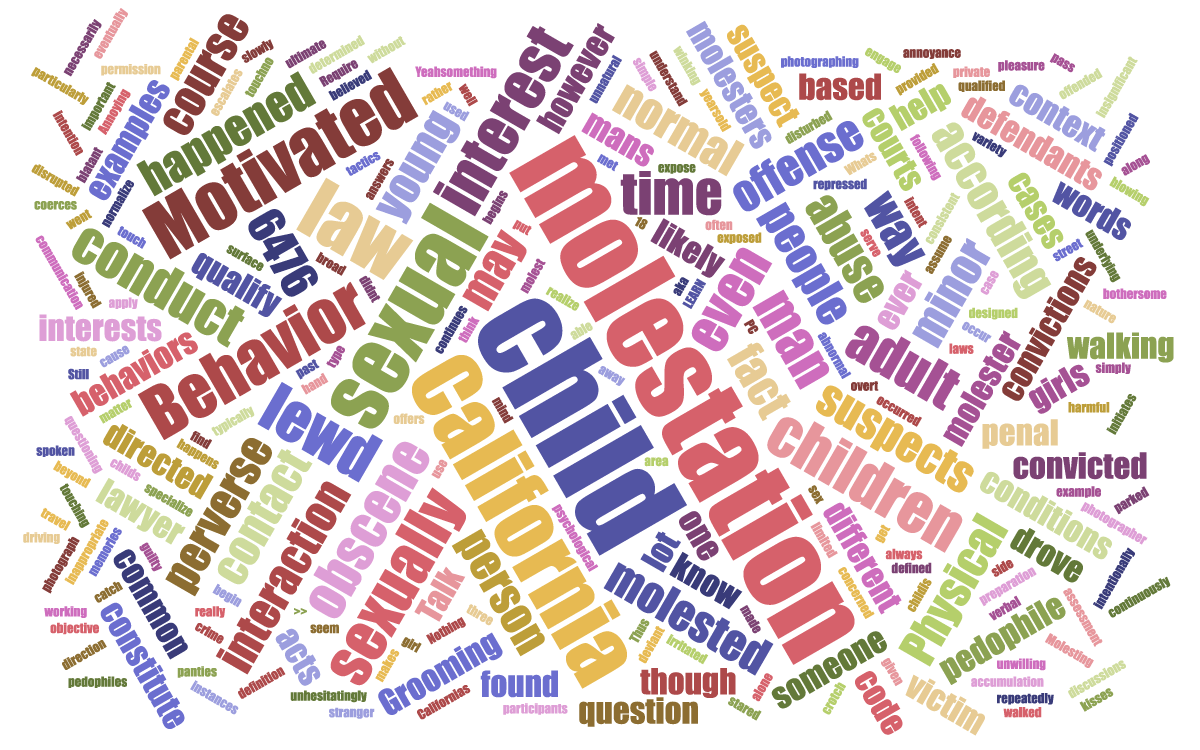Lewd Acts Involving Children

What does Lewd and Lascivious Acts on a Child Mean?
As we discussed in a previous article about California Child Molestation Law, child molestation is not dependent on the child’s state of mind. What determines an act or action as “child molestation” is the intent of the adult who committed the questionable acts. Let’s explore what lewd acts involving children actually are according to California law.
California has several laws regarding child sexual abuse. These laws are designed to help prevent escalated instances of child molestation. They are also designed to stop a range of actions employed by manipulative child molesters. California Penal Code 288 (also known as PC 288), addresses instances of lewd acts involving children.
What is a Lewd or Lascivious Act?
California Penal Code 288 is sometimes referred to as Lewd and Lascivious Acts on a Child. There is a wide range of conditions that classify an act as lewd or lascivious. According to the dictionary, a Lewd Act is any action that is performed with the intent of being lustful and offensive in a sexual way. A Lascivious Act is any action, manner, or gesture that reveals or suggests an overt, and often offensive, sexual desire.
Actions that are lewd, in general, are in bad taste. Actions that are lascivious are, in general, lustful.
PC 288: Lewd Acts Involving Children
In California, an adult may be guilty of committing lewd acts involving children when all of the following conditions apply:
- The child victim was 14 years-old or younger at the time of the incident
- The lewd act(s) committed by the offender were committed upon or with the body or any part of the child with the intent of arousing, appealing to, or gratifying the lust, passions, or sexual desires of the offender or the child.
There are more specific sub-sections to PC 288 that involve lewd acts that are forced or violent. Other sections address situations where the offender is the caretaker of the victimized child(ren). These subsections are highly detailed. But they are designed to cover all of the possible circumstances in which a child could be sexually abused. Nevertheless, the two conditions described above are always necessary for an action to be considered a lewd act involving children.
Common Misconceptions
It is a common misconception that child sexual abuse only occurs in private and always involves an overt sexual act. This is not entirely true. An act can be lewd even though it is not the type of act that we intuitively consider to be grossly sexual. To be clear, there are two categories of acts that make up the foundation of the PC 288.
Category 1. Overt Lewd or Lascivious Acts on a Child
These are acts that can be charged as separate crimes and are punishable under other sections of the law. For example
- Acts of Unlawful Sexual Intercourse (PC 261.5)
- Sodomy (PC 286)
- Oral Copulation (PC 288a)
- Penetration by an Object (PC 289)
Category 2. Other Forms of Touching
Actions in this category are actions that are not necessarily punishable under other sections of the law, but were, nevertheless, performed with an intent to satisfy the sexual interest of the offender or to arouse the child. Examples of actions under category 2 include
- Various touching that is sexually motivated
- Various fondling that is sexually motivated
The Intent of the Offender
In California, it is the sexually motivated intent of the offender that determines an action towards a child to be lewd. Criminally speaking, all lewd and lascivious conduct with a child applies to PC 288. When the offender’s intent is to arouse passion within his or herself or in the child, all actions based in the conduct and manner of performance are considered to be lewd.
Take, for example, a child molestation case from the 1990’s. Here, a child testified that the offender rubbed her stomach, back, and thighs. The particular actions in question were not overtly sexual in nature. However, the touching was considered to be lewd and lascivious because the man’s actions were consistent with a long pattern of conduct that he demonstrated with other young girls. Even though, the offender did not touch the child’s private parts, a jury concluded that the man’s pattern of behavior reasonably showed his intent to satisfy his own sexual interest in the child. Therefore the touching qualified as a lewd or lascivious acts involving a child.
This doesn’t mean that all adults should be afraid of interacting with children. Some adults will, inevitably, touch a child’s back or knee. Adults who play with children, bouncing the kids on their knees, for example, are not necessarily committing a lewd act.
It is also common knowledge that children are routinely cuddled, disrobed, stroked, examined, given affection, and groomed by adults as part of a normal and healthy upbringing. Commonplace behavior like this is not enough, by itself, to infer intent to molest a child. However, if the adult performing these commonplace acts were–at anytime–credibly accused of child sexual abuse, then any commonplace act can be reasonably determined to be a lewd or lascivious act under California law.
Conclusion
PC 288 is ultimately designed to protect children from being used as objects by child molesters. California child molestation law recognizes that children do not have the unique ability to protect themselves against adult offenders. It also recognizes that children experience profound harm when they are perceived as and used as objects of sexual desire.
Therefore, the intent of the adult determines whether their actions are to be considered lewd. Although an act or behavior may outwardly appear to be innocent, the actions qualify as child molestation whenever the offender’s intent is grounded in sexual gratification.
The similarity between the two main California Child Molestation Laws is that the offender’s behavior is based in some sort of sexually deviant motive involving children. The main difference between the two laws is that lewd acts involving children generally involve a mode of conduct that is unquestionably crude, dirty, and offensive.
Annoying or molesting a child is conduct that is simply motivated by an adult’s unhealthy and unnatural sexual desire for children. On the other hand, Lewd Acts Involving Children is conduct that is obscene when taken in the larger context of serving any sort of sexual arousal.
Contact a Child Molestation Lawyer
If you or someone you know was touched by a suspected child molester, it’s best that you seek the advice of a lawyer who specializes in child molestation. An expert child molestation lawyer can help you make sense of the questionable interactions that you or your child had with an adult.

Anthony DeMarco is a California child and teen sexual abuse attorney in Pasadena, CA. He has practiced childhood sexual abuse law since 2002 and has been instrumental in exposing sexual abuse scandals in large organizations such as the Catholic Church, School Districts, Youth Sports, Police Departments, and Youth Organizations.




